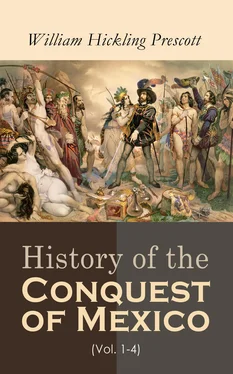In addition to this tax on all the agricultural produce of the kingdom, there was another on its manufactures. The nature and the variety of the tributes will be best shown by an enumeration of some of the principal articles. These were cotton dresses, and mantles of feather-work exquisitely made; ornamented armor; vases and plates of gold; gold dust, bands and bracelets; crystal, gilt, and varnished jars and goblets; bells, arms, and utensils of copper; reams of paper; grain, fruits, copal, amber, cochineal, cacao, wild animals and birds, timber, lime, mats, etc. [76]In this curious medley of the most homely commodities and the elegant superfluities of luxury, it is singular that no mention should be made of silver, the great staple of the country in later times, and the use of which was certainly known to the Aztecs. [77]
Garrisons were established in the larger cities,—probably those at a distance and recently conquered,—to keep down revolt, and to enforce the payment of the tribute. [78] [79]Tax-gatherers were also distributed throughout the kingdom, who were recognized by their official badges, and dreaded from the merciless rigor of their exactions. By a stern law, every defaulter was liable to be taken and sold as a slave. In the capital were spacious granaries and warehouses for the reception of the tributes. A receiver-general was quartered in the palace, who rendered in an exact account of the various contributions, and watched over the conduct of the inferior agents, in whom the least malversation was summarily punished. This functionary was furnished with a map of the whole empire, with a minute specification of the imposts assessed on every part of it. These imposts, moderate under the reigns of the early princes, became so burdensome under those at the close of the dynasty, being rendered still more oppressive by the manner of collection, that they bred disaffection throughout the land, and prepared the way for its conquest by the Spaniards. [80]
Communication was maintained with the remotest parts of the country by means of couriers. Post-houses were established on the great roads, about two leagues distant from each other. The courier, bearing his despatches in the form of a hieroglyphical painting, ran with them to the first station, where they were taken by another messenger and carried forward to the next, and so on till they reached the capital. These couriers, trained from childhood, travelled with incredible swiftness,—not four or five leagues an hour, as an old chronicler would make us believe, but with such speed that despatches were carried from one to two hundred miles a day. [81]Fresh fish was frequently served at Montezuma’s table in twenty-four hours from the time it had been taken in the Gulf of Mexico, two hundred miles from the capital. In this way intelligence of the movements of the royal armies was rapidly brought to court; and the dress of the courier, denoting by its color the nature of his tidings, spread joy or consternation in the towns through which he passed. [82]
But the great aim of the Aztec institutions, to which private discipline and public honors were alike directed, was the profession of arms. In Mexico, as in Egypt, the soldier shared with the priest the highest consideration. The king, as we have seen, must be an experienced warrior. The tutelary deity of the Aztecs was the god of war. A great object of their military expeditions was to gather hecatombs of captives for his altars. The soldier who fell in battle was transported at once to the region of ineffable bliss in the bright mansions of the Sun. [83]Every war, therefore, became a crusade; and the warrior, animated by a religious enthusiasm like that of the early Saracen or the Christian crusader, was not only raised to a contempt of danger, but courted it, for the imperishable crown of martyrdom. Thus we find the same impulse acting in the most opposite quarters of the globe, and the Asiatic, the European, and the American, each earnestly invoking the holy name of religion in the perpetration of human butchery.
The question of war was discussed in a council of the king and his chief nobles. [84]Ambassadors were sent, previously to its declaration, to require the hostile state to receive the Mexican gods and to pay the customary tribute. The persons of ambassadors were held sacred throughout Anahuac. They were lodged and entertained in the great towns at the public charge, and were everywhere received with courtesy, so long as they did not deviate from the high-roads on their route. When they did, they forfeited their privileges. If the embassy proved unsuccessful, a defiance, or open declaration of war, was sent; quotas were drawn from the conquered provinces, which were always subjected to military service, as well as the payment of taxes; and the royal army, usually with the monarch at its head, began its march. [85]
The Aztec princes made use of the incentives employed by European monarchs to excite the ambition of their followers. They established various military orders, each having its privileges and peculiar insignia. There seems, also, to have existed a sort of knighthood of inferior degree. [86]It was the cheapest reward of martial prowess, and whoever had not reached it was excluded from using ornaments on his arms or his person, and obliged to wear a coarse white stuff, made from the threads of the aloe, called nequen . Even the members of the royal family were not excepted from this law, which reminds one of the occasional practice of Christian knights, to wear plain armor, or shields without device, till they had achieved some doughty feat of chivalry. Although the military orders were thrown open to all, it is probable that they were chiefly filled with persons of rank, who, by their previous training and connections, were able to come into the field under peculiar advantages. [87]
The dress of the higher warriors was picturesque and often magnificent. Their bodies were covered with a close vest of quilted cotton, so thick as to be impenetrable to the light missiles of Indian warfare. This garment was so light and serviceable that it was adopted by the Spaniards. The wealthier chiefs sometimes wore, instead of this cotton mail, a cuirass made of thin plates of gold or silver. Over it was thrown a surcoat of the gorgeous feather-work in which they excelled. [88]Their helmets were sometimes of wood, fashioned like the heads of wild animals, and sometimes of silver, on the top of which waved a panache of variegated plumes, sprinkled with precious stones and ornaments of gold. They wore also collars, bracelets, and ear-rings of the same rich materials. [89]
Their armies were divided into bodies of eight thousand men; and these, again, into companies of three or four hundred, each with its own commander. The national standard, which has been compared to the ancient Roman, displayed, in its embroidery of gold and feather-work, the armorial ensigns of the state. These were significant of its name, which, as the names of both persons and places were borrowed from some material object, was easily expressed by hieroglyphical symbols. The companies and the great chiefs had also their appropriate banners and devices, and the gaudy hues of their many-colored plumes gave a dazzling splendor to the spectacle.
Their tactics were such as belong to a nation with whom war, though a trade, is not elevated to the rank of a science. They advanced singing, and shouting their war-cries, briskly charging the enemy, as rapidly retreating, and making use of ambuscades, sudden surprises, and the light skirmish of guerilla warfare. Yet their discipline was such as to draw forth the encomiums of the Spanish conquerors. “A beautiful sight it was,” says one of them, “to see them set out on their march, all moving forward so gayly, and in so admirable order!” [90]In battle they did not seek to kill their enemies, so much as to take them prisoners; [91]and they never scalped, like other North American tribes. The valor of a warrior was estimated by the number of his prisoners; and no ransom was large enough to save the devoted captive. [92]
Читать дальше












